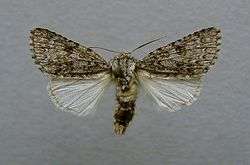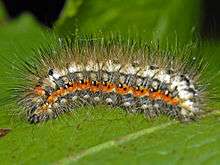Acronicta euphorbiae
| Acronicta euphorbiae | |
|---|---|
 | |
| Scientific classification | |
| Kingdom: | Animalia |
| Phylum: | Arthropoda |
| Class: | Insecta |
| Order: | Lepidoptera |
| Family: | Noctuidae |
| Genus: | Acronicta |
| Species: | A. cuspis |
| Binomial name | |
| Acronicta euphorbiae (Denis & Schiffermüller, 1775) | |
| Synonyms | |
| |
The sweet gale moth (Acronicta euphorbiae) is a moth of the family Noctuidae.
Similar species
Distribution
This species is distributed through parts of the Palearctic South of a line that is across southern Poland, from northern Scotland, Northeastern Netherlands/border with North-Western Germany, southeastward through the northern Czech Republic, the Ukraine and southern Russia to the Ural mountains.[2][3]
Habitat
These moths prefer warm, sunny slopes, grassy heaths, moorland and forests. In the Alps, they rise up to over 2500 metres above sea level. [4]
Description

The wingspan of Acronicta euphorbiae can reach 32–40 mm. The females are slightly larger than the males and have darker hindwings. [5] Forewings are grey dusted with darker; orbicular stigma is close beyond inner line; hindwings are white in male, fuscous in female with pale cilia. The ab. montivaga Guen. is a mountain form, with darker, bluer grey forewings, occurring in the Alps and in Norway. The ab. myricae Guen., occurring in the Scotch and Irish mountains, is still darker, with narrower, more pointed forewings, but not smaller as Staudinger states. The ab. euphrasiae Brahm, which appears to be the commoner form in France and S. W. Europe, is paler than the type and more luteous; Lastly, the ab. esulae. Hbn. is a quite, small form, with the markings obscured.[6]
Unlike adults the caterpillars are brightly colored, with hairy spikes. They gets more colorful as they grow.
Biology
The adults fly at night from May to June . The larva feed on a wide range of plants, mainly on heather (Calluna vulgaris), bog-myrtle (Myrica gale), Euphorbia, Achillea, Rumex and Plantago.[4][5][7]
Notes
- ^ The flight season refers to the British Isles. This may vary in other parts of the range.
References
- ↑ Biolib
- ↑ Walter Forster und Theodor Wohlfahrt: Die Schmetterlinge Mitteleuropas, Band IV, Eulen. Franckh'sche Verlagshandlung, Stuttgart 1971
- ↑ Fauna Europaea
- 1 2 Lepidoptera.eu
- 1 2 UK Moths
- ↑ Seitz, A. Ed., 1914 Die Großschmetterlinge der Erde, Verlag Alfred Kernen, Stuttgart Band 3: Abt. 1, Die Großschmetterlinge des palaearktischen Faunengebietes, Die palaearktischen eulenartigen Nachtfalter, 1914
- ↑ "Robinson, G. S., P. R. Ackery, I. J. Kitching, G. W. Beccaloni & L. M. Hernández, 2010. HOSTS - A Database of the World's Lepidopteran Hostplants. Natural History Museum, London.".
| Wikimedia Commons has media related to Acronicta euphorbiae. |
External links
Further reading
- South R. (1907) The Moths of the British Isles,(First Series), Frederick Warne & Co. Ltd., London & NY: 359 pp. online